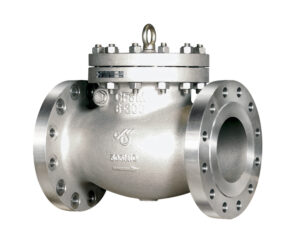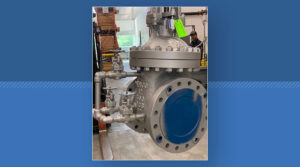
Stainless Steel Valves
Stainless steel valves are one of the most common types because they offer great durability at a relatively low cost. In this article, you will learn more about stainless steel valves and compare them vs other valve materials.
More on Stainless Steel Valves
Stainless steel material is an iron alloy with elements including nickel and chromium in variable quantities, depending on the grade. By varying the proportions of these additional elements, stainless steel can provide desirable features for valves, such as corrosion resistance, durability, high temperature and pressure tolerance, and versatility.
- Corrosion Resistance: An outstanding attribute of stainless steel valves is their corrosion resistance. In an industrial setting, this is important because most valves are either in sweet or sour service. Stainless steel excels in such corrosive environments as it quickly passivates, forming a corrosion-resistant layer at its surface. For stainless steel 316, the presence of nickel and molybdenum makes it especially resistant to chlorides. As a result, it thrives in marine environments.
- Durability: Stainless steel valves are quite durable in comparison to other materials. They provide high abrasion resistance. So they adequately resist erosion in dangerous settings such as sand particles in high-speed gas streams. Also, they effectively resist shock damage from impacts such as water hammer. As a result, stainless steel valves are ideal for heavy-duty applications such as mining operations.
- High Temperature and Pressure Tolerance: The robustness of stainless steel valves extends to their ability to work efficiently in high-temperature and high-pressure applications. Ferritic grades are suitable for operating between 1,022℉ (550℃) and 1,562℉ (850℃). With higher alloy grades such as 4736, 4762, and 4742 functioning at temperatures up to 2,730°F. All these while maintaining excellent resistance to reducing sulfur attacks.
- Versatility: Stainless steel valves are among the most versatile on the market. As an alloy, its composition, especially of molybdenum, chromium, and nickel, can be adjusted to meet specific project needs. These needs could include resistance to certain types of corrosion, increase in strength, etc.
Comparison to Other Materials
Apart from stainless steel, there are other materials that serve in the manufacture of valves. This section compares the features of some of these materials to that of stainless steel.
Stainless Steel vs Brass
| Parameter | Difference Between Stainless Steel vs Brass |
| Corrosion Resistance | Stainless steel valves perform better than brass valves, especially in marine environments. This is important because corrosion in valves can result in difficulty when closing or opening. |
| Welding | Because of its chemical composition, brass is easier to weld than stainless steel. Moreover, this gives brass valves more versatility when putting it together with other parts of a system. To weld stainless steel, it is necessary to first break down its oxide layer. |
| Application | Stainless steel enjoys wide adoption because slight alteration to its composition provides a wide range of features. Brass is not ideal for use in the food and pharmaceutical industry because it contains lead. To use brass in such applications, they must be certified lead-free by the FDA. |
| Cost | Generally, brass is a cheaper option than stainless steel. However, lead-free brass costs about the same and is even more expensive than some stainless steel grades. |
| Temperature and Pressure Rating | Stainless steel is a better option than brass for valves in high-temperature and high-pressure applications. For example, a standard stainless ball valve could have a rating of 1,000 psi on a one-inch model. Its brass counterpart could have a rating of 600 psi. |
Stainless Steel vs Titanium
| Parameter | Stainless Steel vs Titanium Valves |
| Hardness | Although stainless steel’s Brinell hardness varies widely depending on its alloy composition, it is generally tougher than titanium. As a result, it offers more resistance in applications with significant or fast-moving debris that can scratch the valve. |
| Durability | Generally, stainless steel has more yield and tensile strength than titanium. However, titanium has a better strength-to-weight ratio, so it can deliver the same strength but at 40% of the weight of steel. This makes titanium valves potentially a better choice than stainless steel win lightweight systems. |
| Cost | Titanium valves are significantly more expensive than stainless steel for a bunch of reasons. Titanium’s raw materials are rare, the extraction process is energy-intensive, and machining it is more difficult than stainless steel. Also, due to its excellent combination of strength and lightweight, titanium’s global demand is very high. |
| Application | Titanium valves are ideal for food, pharmaceutical, and other sensitive applications because of their biocompatibility. Also, titanium valves have better corrosion and thermal resistance. |
Stainless Steel vs Inconel
| Parameter | Stainless Steel vs Inconel Valves |
| High Temperature | Although stainless steel generally has more strength, Inconel valves retain their strength over a wider temperature range. Stainless steel can creep and lose strength in extreme temperature applications. |
| Corrosion Resistance | Inconel valves are superior to stainless steel when it comes to corrosion resistance. Especially the Inconel 625 alloy, which has proportions of chromium and nickel. |
| Cost | Inconel valves are significantly more expensive than stainless steel. |
| Application | Inconel valves are the go-to option for extreme conditions such as cryogenic service. Also, they have a high strength-to-weight ratio, so they are good for lightweight applications. |
Premium Offerings at QRC
At QRC, we have a wide variety of stainless steel valves that will meet your project needs. Some of these stainless steel valve options include:
- Cameron’s ORBIT rising stem ball valves are ideal for applications that require zero leakage and frequent operations. These are popular globally in gas processing plants using molecular sieve systems in switching services.
- Durco valves; high-performance triple offset butterfly valves; non-lubricated plug valves for chemical service; and fluoropolymer lined plug valves.
- L&T gate, globe, and check valves that suit HIPPS, emergency shutdown, ultra-high pressure, oxygen/clean service, and cryogenic applications.
- Newco gate, globe, ball, check, and triple offset butterfly valves.
- Xanik pressure seal valves.
- DSI bolted-bonnet gate, globe, and check valves.
- Also, Poyam gate, globe, and check valves.


